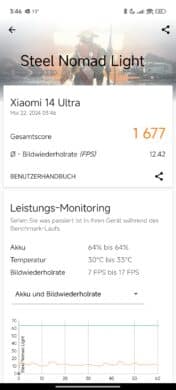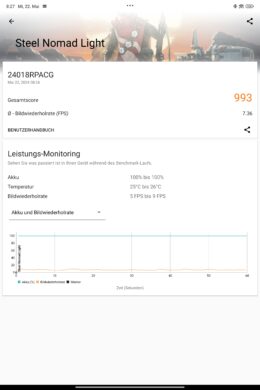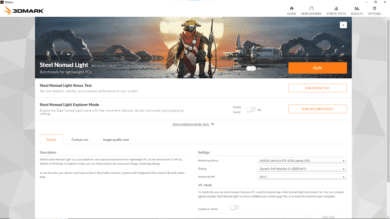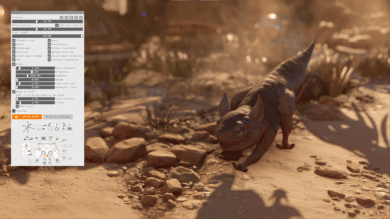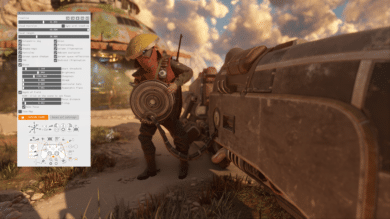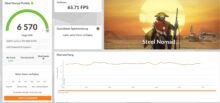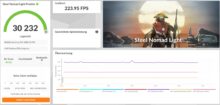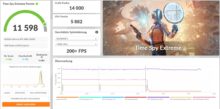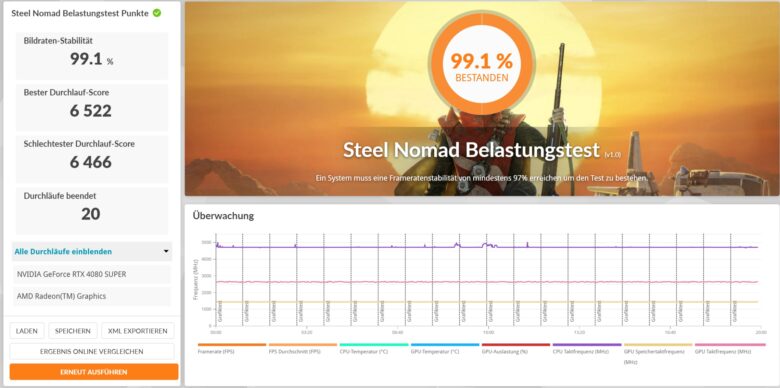
The 3DMark graphics benchmarks from UL Solutions are also an integral part of our PC and notebook tests. The well-known Time Spy test based on DirectX 12 has been part of this for years. This has now been given a successor called 3DMark Steel Nomad, which is designed to compare the performance of gaming PCs and notebooks. We took a closer look at the 60-second test before its launch.
What’s your score? Post your Steel Nomad Results in our Forums
Update: The first Mobile Resuilts are In
Steel Nomad and the light version were officially launched on the evening of May 21. We took this as an opportunity to test smartphones and tablets with the mobile version of 3DMark Steel Nomad Light.
Specifically, we tested the Xiaomi 14 Ultra (our review) with the current flagship SoC Qualcomm Snapdragon 8 Gen 3, as well as the tablet offshoot Xiaomi Pad 6S Pro (our review) with last year’s Qualcomm Snapdragon 8 Gen 2 chip.
This confirms that Steel Nomad Light is significantly more demanding than 3DMark Wild Life Extreme. The flagship camera smartphone achieves an average of 12.42 frames per second (fps) in the new benchmark, compared to 28.13 fps in the older Wild Life Extreme test.
Solar Bay also delivers significantly higher values and frame rates than Steel Nomad Light. So even the fastest chip currently available has problems delivering a smooth gaming experience here. Of course, this is not surprising, as the new gaming benchmark is supposed to demand absolutely everything from the devices – and will continue to do so for years to come.
In contrast, the previous year’s chip in the tablet only achieved an average refresh rate of 7.36 fps.
| Score | Average Framerate | |
| Xiaomi 14 Ultra | 1.677 Pts. | 12,42 fps |
| Xiaomi Pad 6S Pro | 993 Pts. | 7,36 fps |
3DMark Steel Nomad is here
3DMark Steel Nomad is a cross-platform benchmark for high-end gaming PCs, but UL Solutions also offers a lighter version called 3DMark Steel Nomad Light.
It marks the successor to Time Spy from 2016 and is the latest sophisticated rasterizer benchmark in the suite. Unlike Speed Way, Port Royal or Solar Bay, Steel Nomad does not rely on ray tracing effects.
There are differences in the resolution, for example, as 3DMark Steel Nomad uses 4K UHD, while the light version uses QHD (2,560 x 1,440 pixels). Compared to Time Spy, the resolution has therefore increased, while new effects such as Volumetric Skies and Procedural Grass as well as familiar ones (Volume Illumination, Ambient Occlusion and Depth-of-Field) are used more.
The result is a benchmark that is significantly more demanding than Time Spy and realizes correspondingly lower frame rates (fps), but also looks significantly better and should therefore come close to modern PC games.
Accordingly, the higher level of detail and the higher-resolution textures immediately catch the eye. Edge smoothing is also significantly better thanks to TAA.
The cross-platform benchmark 3DMark Steel Nomad is currently designed for Windows and Windows on Arm and supports both DirectX 12 and Vulkan. An implementation for macOS (with Metal API), Linux (Vulkan) as well as for Android and iOS is to follow.
- OS: Windows 11 or Windows 10, 64-bit (Version 21H2)
- CPU: 1.8 GHz dual-core with SSSE3 support
- Memory: 8 GB RAM
- Graphics: DirectX 12 feature level 12.0 capable GPU and shader model 6.0
- Graphics memory: 6 GB VRAM
- Disk space: 1.5 GB
- OS: Windows 11 or Windows 10, 64-bit (Version 21H2)
- CPU: 1.8 GHz dual-core with SSSE3 support
- Memory: 8 GB RAM
- Graphics: DirectX 12 feature level 12.0 capable GPU and shader model 6.0
- Graphics memory: 4 GB VRAM
- Disk space: 1.5 GB
Stress test and explorer mode
In addition to the normal 3DMark Steel Nomad and Steel Nomad Light test, the provider also provides a stress test, which evaluates the reliability, stability and sustained performance of the system. We are already familiar with this from other benchmarks.
What is new, however, is the Explorer mode, in which the benchmark scene can be freely explored. All parameters can be freely adjusted to see how they affect the visual effects, performance and much more.
In V.S mode, Steel Nomad can compare its own performance directly with friends or the 3D Mark Hall of Fame. It is also possible to compare with your own previous results to see how the performance of your PC or notebook has changed over time.
The following test scenario is recommended for gaming PCs:
- Speed Way – Heavy Ray Traced Gaming
- Steel Nomad – demanding games without ray tracing
- Solar Bay – light ray traced gaming
- Port Royal – medium ray tracing game
Things get interesting in the area of mobile devices with smartphones, handhelds and tablets. This is where the test scenario expands:
- Solar Bay – cross-platform light ray-traced gaming
- Steel Nomad Light – medium cross-platform gaming without ray tracing
- Wild Life Extreme – cross-platform light gaming without ray tracing
3DMark Steel Nomad in the first test
Interesting: 3DMark Steel Nomad and the light version now show the frame rate of FPS instead of a graphics score. A value that is much easier to work with (and compare) in the gaming sector than a quasi meaningless number.
The first test shows that Steel Nomad Light produces a higher final score than Time Spy in terms of the overall result. And that with significantly better graphics and the same A resolution of QHD.
In the case of the embargo on Whit Monday, we have so far only had the opportunity to run the new benchmark tests on our test system. It looks like this:
Test system:
- CPU: AMD Ryzen 7 7800X3D
- Memory: 64 GB DDR5-6000 RAM
- GPU: NVIDIA GeForce RTX 4080 Super
- Graphics driver version GeForce 552.44
| Benchmark | Results |
| 3DMark Time Spy (QHD) | 23.846 pts. |
| 3DMark Time Spy Extreme (4K) | 11.598 pts. |
| 3DMark Steel Nomad (4K) | 6.570 pts (65.71 FPS) |
| 3DMark Steel Nomad Light (QHD) | 30.232 pts (223.95 FPS) |
A direct comparison with the Hall of Fame, but also other external tests, shows that AMD graphics cards, especially the top models Radeon RX 7900 XTX and RX 7900 XT, are at the forefront in the new 3DMark Steel Nomad benchmark.
Precisely because the new graphics test does not rely on ray tracing. An area in which the GPUs from the red camp are clearly at a disadvantage. In addition, Vulkan is often the faster interface for AMD GPUs, while DirextX 12 usually delivers the better results for NVIDIA. However, both APIs are often very close to each other.
Most of the time, but not always. In the test with the NVIDIA GeForce RTX 4080 Super, we were also able to achieve significantly better results with the Vulkan API. With Intel’s ARC GPUs, however, DirectX 12 is clearly ahead.
| Steel Nomad DirectX 12 (best score) | Steel Nomad Vulkan (best score) |
| 6.570 points (65.71 FPS) | 7.099 pts (71.00 FPS) |

Overall, this puts the RTX 4080 Super in third place among the fastest graphics cards, at least if you ignore any overclocking. The AMD Radeon RX 7900 XTX achieves an average of 2-5 percent more performance, not least thanks to 24 GB of graphics memory, while NVIDIA’s top model, the RTX 4090, ranks a full 37-40 percent ahead of the RTX 4080 Super on average.
3DMark Steel Nomad test: Conclusion
With 3DMark Steel Nomad and the light version, UL Solutions has launched a very sophisticated and stylish rasterizing benchmark, which also allows a very good synthetic comparison between different systems thanks to its cross-platform usability.
With a runtime of 60 seconds and the absence of a demo, the benchmark is also very fast. It is interesting to note that Vulkan is currently still ahead – and in some cases clearly so. It remains to be seen whether AMD and NVIDIA in particular will be able to catch up with updated drivers for the DorectX 12 interfaces.
In the short or long term, Steel Nomad will overtake the outdated Time Spy test and will be an interesting choice for AMD and Intel graphics cards in particular, as they are sometimes clearly outperformed by NVIDIA in the ray tracing tests.
It will also be interesting to see how smartphones, tablets and gaming handhelds perform in the light version in the future and how the differences to dedicated GPUs will turn out.
Steel Nomad will be released on May 21, 2024 as a free update in 3DMark and can also be used without a paid license.
